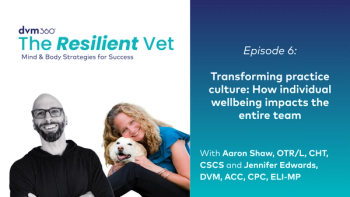
The business case for workplace well-being
In veterinary practices, success leads to happiness, right? Not so fast. Its happiness that breeds business success, say psychology experts. And theres research to prove it.
Happiness in the workplace (are you happier looking at this corgi?) could lead to business success, say researchers. (tatomm/stock.adobe.com)For most of my life I believed achievement and success would lead to happiness. I'd say things like, “if I graduate college, I'll be happy” or “I'll be happy when I make more money.” So I set my mind to those goals and achieved them. I got my degree, bought into a veterinary hospital, sold my equity and bought into a second hospital, joined a consulting company and worked with a veterinary consolidating startup.
Want to know how to do this?
Dive deeper into improving workplace well-being in these articles:
For the team:
For you and your team:
For your life:
Well on my way to major financial success, I found myself standing over my breakfast in tears one morning-burnt out and as unhappy as I'd ever been.
In veterinary medicine, I am not alone. Results of the Merck Animal Health Veterinary Wellbeing Study,
I believe we veterinary professionals have bought into the conventional mindset that success leads to happiness. Not only is this mindset wrong, it's harming us.
Happiness fuels success
In his book The Happiness Advantage,
Two decades of research in the fields of positive psychology, organizational psychology and neuroscience have proven time and again that a happy brain performs better. In the workplace this so-called happiness advantage leads to better business performance. That is, companies with happy employees enjoy better business outcomes, veterinary hospitals included.
The Losada line
In 1998, social psychologist Barbara Frederickson, PhD, introduced
Following on this work, researcher and consultant Marcial Losada, PhD, set out to determine whether positive experiences in the workplace might lead to business success. He studied corporate teams and categorized their interpersonal interactions as positive or negative. He found that the highest-performing teams had at least a 3:1 ratio of positive to negative interactions.
The highest-performing teams had at least a 3:1 ratio of positive to negative interactions.
In a fascinating example of the power of his findings, Dr. Losada worked closely with a struggling global mining company. Overall, the company had a ratio of about one positive experience for every one negative experience. After team leads were coached for nine months on methods for increasing positive experiences in the workplace, the ratio grew to 3.56-to-1, increasing team productivity by over 40%.6
Oxytocin, the trust molecule
Trained in economics and neuroscience,
Dr. Zak developed a system for measuring oxytocin in employees in real time. He's shown that an increase in an organization's overall oxytocin level by a single quartile results in a 25% boost in productivity, a 27% decrease in employee turnover and a decrease in sick time used by an average of two days per employee.
His research also unearthed simple ways to increase oxytocin in an organization's culture, such as by regularly recognizing staff contributions and providing guided autonomy in the workplace. In his words, “adding up the value of the increased productivity and retention … the total additional revenue each colleague would produce after moving up one quartile in trust would be $10,185.”7 In a veterinary hospital with a staff of 10, that totals more than $100,000 in additional revenue.
Putting the theory to work: gratitude
The options for improving workplace happiness are as myriad as they are targeted. What works for one organization may not work for another, but one tool that does appear to work well for most businesses is gratitude.
A 2016 meta-analysis showed that regular gratitude practice increases well-being.8 Include gratitude in your hospital's daily huddle or rounds by asking everyone to share one good thing they've experienced in the past 24 hours.
Clearly, a business case for workplace well-being exists. I believe a moral case exists as well. In caring for ourselves and each other we build our individual and collective potential. We feel better, we do better, we care better and our hospitals succeed.
References
1. Volk JO, Shimmack U, Strand EB, et al. (2018). Executive summary of the Merck Animal Health Veterinary Wellbeing Study. Journal of the American Veterinary Medical Association 252(10):1231-1238
2. Larkin M. Suicide rate in profession stretches back decades. American Veterinary Medical Association website:
3. Achor S. The Happiness Advantage. New York: Publishing Group, 2010.
4. Lyubomirsky S. .King L, Diener E The benefits of frequent positive affect: Does happiness lead to success? Pyschol Bull 2005;131(6):803-855.
5. Fredrickson BL. (1998). What good are positive emotions? Rev Gen Psychol 1998;2(3):300-319.
6. Losada M. Work teams and the Losada line: new results. Positive Psychology News website:
7. Zak PJ. Trust Factor: The science of creating high-performance companies. New York: AMACOM, 2017.
8. Davis DE, ChoeE, Meyers J, et al. Thankful for the little things: A meta-analysis of gratitude interventions. J Couns Psychol 2016;63(1): 20-31.
Newsletter
From exam room tips to practice management insights, get trusted veterinary news delivered straight to your inbox—subscribe to dvm360.





